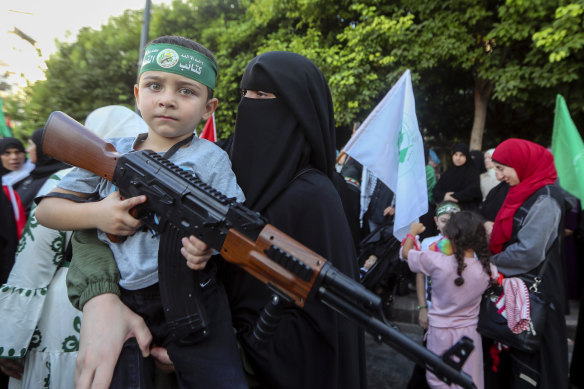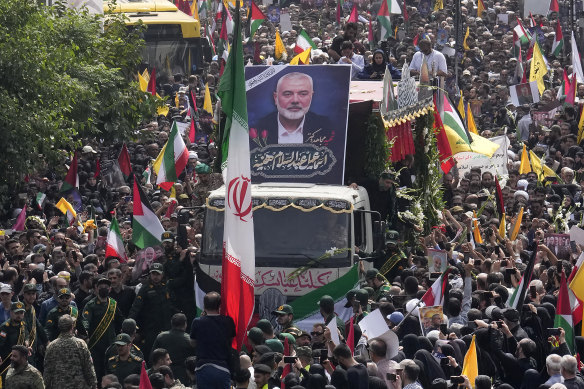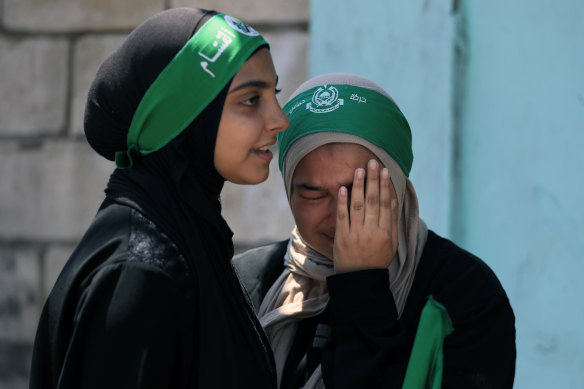How a battered Hamas may emerge stronger despite recent killings
By Erika Solomon
First came the death of its top leader abroad, Ismail Haniyeh, by a bomb planted in Tehran. Then came Israel’s announcement that, only weeks earlier, it had killed Hamas’ most elusive and revered military leader. All of this as Israel continues to wage the deadliest war Palestinians in the Hamas-ruled Gaza Strip have ever faced.
The latest score in the 30-year struggle between Israel and Hamas looks like a devastating one for the Islamist movement, one that throws its future into question. Yet the history of Hamas, the evolution of Palestinian militant groups over the decades and the logic of insurgencies more broadly suggest that not only will Hamas survive, it may even stand to emerge politically stronger.

A supporter of the Islamist Hamas movement carries her son, who holds a machine gun toy during a protest in the southern port city of Sidon, Lebanon.Credit: AP
Analysts and regional observers in contact with Hamas leaders see the latest blows it has suffered, including Haniyeh’s assassination, widely believed to be at Israel’s hand, as offering Israeli forces a short-term victory at the cost of long-term strategic success.
“Instead of creating the disconnect they’d hoped for, one that would make people fearful or completely defeated, this will have the opposite effect,” said Tahani Mustafa, a senior Palestine analyst at the International Crisis Group, which provides policy analysis on ending conflicts. “Israel just dealt them a winning hand.”
The military campaign Israel has waged in retaliation for Hamas’ October 7 attacks has displaced about 90 per cent of Gaza’s 2 million residents, razed swaths of the enclave’s cities and killed 39,000 people, according to Gaza’s health ministry, which does not distinguish between civilians and combatants.
Despite that, Hamas not only remains operational, but is recruiting new fighters in Gaza and beyond, local residents and analysts say. Militants have also begun to re-emerge in areas that Israel had driven them out of months before.
For Hamas, the logic of insurgency means that simply surviving in the face of a far more powerful military provides a symbolic victory. With that comes a chance at staying power that outlasts any pain Israel has inflicted.
On Wednesday, Israel’s military said that a strike it conducted on July 13 had killed Muhammad Deif, the head of Hamas’ military wing, who is seen as an architect of the October 7 attack on Israel. Hamas has yet to confirm the killing.
Deif’s death, however, would represent the end of a years-long Israeli effort to kill the man who is effectively the second-most senior leader after Israel’s most-wanted man, Yahya Sinwar, the head of Hamas in Gaza.
Israel’s announcement of Deif’s killing came on the day that mourners were gathering to bid farewell to Haniyeh, who was killed while on a visit to attend the inauguration of Iran’s new president. Iran and Hamas have accused Israel, with a long history of assassinating its foes, of being behind his death.

Iranians follow a truck carrying the coffins of Hamas leader Ismail Haniyeh and his bodyguard, who were killed in an assassination blamed on Israel.Credit: AP
His loss, too, will be difficult for Hamas. Haniyeh was seen by regional analysts as a more moderate figure within the Islamist movement, acting as a bridge between its rival factions. He was also seen as a leader willing to push for mediation, including the continuing, if faltering, ceasefire talks with Israel.
“You take him out and the message is: negotiations don’t matter,” said Khaled Elgindy, an expert on Palestinian affairs at the Middle East Institute in Washington.
“I don’t see a reason to conclude Hamas could become irrelevant,” he said. “The question is: How does Hamas change after this? And I think there is a very strong argument to be made that the leadership becomes more hardline.”
Deif replaced Ahmed al-Jabari, the military leader Israel killed in 2012 with a targeted strike on his car. At the time, he was leading Hamas’ side in a mediation effort to reach a long-term ceasefire with Israel.
Israel’s decades-long targeted killing campaigns against its Palestinian and regional rivals have a contested record. Critics have long argued the tactic has simply created room for new parties or leaders to emerge as Israel’s main foes, often with ever more radical forces replacing them.
In the 1970s, Israel killed Wadi Haddad, the military leader of the communist Popular Front for the Liberation of Palestine, which led to that group’s collapse. A decade later, a new Palestinian foe had replaced it: Yasser Arafat’s nationalist force, Fatah. Israel killed its popular military leader, Khalil al-Wazir, but failed to cripple the group.
Hamas, founded in 1987, has intently studied the history of Palestinian militant groups in the hopes of avoiding their fates.
Since the early 2000s, Hamas has become the group seen by Palestinians as taking up the mantle of armed resistance to Israeli occupation while other groups’ military abilities have faded.
As peace talks broke down in the early 2000s, Hamas’ potency grew. Several Israeli assassinations of its leaders, including its co-founders, failed to derail the group.
Haniyeh’s life story provides a different lesson in the unintended consequences of some of Israel’s attempts to incapacitate Hamas. He was among 400 Palestinians expelled by Israel from Gaza to southern Lebanon, then under Israeli military occupation. Instead of being sidelined, figures like Haniyeh gained further popularity.
Perhaps the most important principle for Hamas’ survival, analysts say, is not being overly reliant on material support from its foreign backers.
Hamas so far appears to have maintained that self-reliance even amid Israel’s tightened siege on Gaza. Iran is a major source of Hamas’ money and weapons. Its attack drones were used by Hamas on October 7. But now Iran is also struggling to keep itself from being dragged into a regional war.

A young woman reacts during a protest in Lebanon to condemn the killing of Hamas political chief Ismail Haniyeh.Credit: AP
Hamas militants have their own engineers who know how to make use of whatever they can find on the ground, from supplies looted from Israeli bases or ambushes on Israeli vehicles, or from extracting materials from unexploded ordnance and fallen drones.
“They got a lot of external support in terms of finance and training, but in terms of their logistics, a lot of that is homemade,” Mustafa said. “Which is why, even now, almost 10 months in, you haven’t seen the resistance wane.”
Not all Hamas observers believe that Hamas can survive the current pressures. Some analysts, such as Michael Stephens at the London-based research group the Royal United Services Institute, believe the strikes will cause enough temporary damage to force Hamas into more concessions.
Akram Atallah, a Palestinian political analyst at the Arabic newspaper Al-Ayyam, said Hamas would emerge from this war badly damaged, not only militarily, but in terms of support in Gaza, the region that “has always been its centre of gravity.”
‘No one wants to go there because no one wants to own that problem. Who is going to own the Palestinian question?’
Palestinian analyst Michael Stephens from London’s Royal United Services Institute
Much of the popularity Hamas is perceived to have gained, he said, had come from outside Gaza, such as from fellow Palestinians in the occupied West Bank.
“That is understandable for one obvious reason: it’s the residents of Gaza who are paying the price,” he said.
Hamas, he said, would never be able to lead the Gaza Strip after Israel’s offensive ended. Not only Israel and its main backers in Washington would reject this, he said, but Palestinians too.
Yet even with that resolve, Hamas’ opponents had done little to ensure that anyone could replace Hamas, Stephens said.
“No one wants to go there because no one wants to own that problem,” he said. “Who is going to own the Palestinian question? It looks bad for Hamas right now, but then what exactly are the alternatives?”
Mustafa predicts an extended period in which Gaza is trapped in a power vacuum, with Israel entering and withdrawing from pockets where Hamas militants re-emerge and disappear.
Even if Israel were to ultimately deal a decisive blow against Hamas, Atallah said, the only question would be who emerged next.
“As long as there is an occupation, Palestinians will keep fighting,” he said, “whether there is still a Hamas, or there isn’t.”
This article originally appeared in The New York Times.
Get a note directly from our foreign correspondents on what’s making headlines around the world. Sign up for our weekly What in the World newsletter.